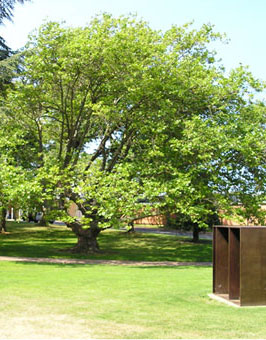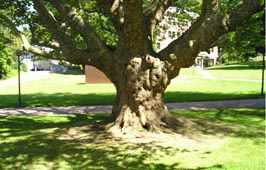18. Plane tree 'Pyramidalis' (Platanus x acerifolia Pyramidalis)
Location: Old Main Meadow, north of Bird Sanctuary
Most of us, walking past this visually compelling, well-loved tree, will say, "At least I know that one. It's a sycamore". (I know I did). Well, yes and no. Yes, it belongs to genus Platanus - in America, the sycamores. However, it isn't the American sycamore. Instead, it is a sprawling, space-consuming mutant variety of the plane tree, that iconic London street-and-park tree with which every visitor quickly becomes familiar. The plane tree in turn is a hybrid of the American sycamore (Platanus occidentalis) of eastern North America and the Oriental plane (Platanus orientalis), native to the Balkans and Asia Minor east to the Himalayas. The cross must have been made early; plane trees are known in London from the mid-1600s. But not 'Pyramidalis', which requires too much room. For a glimpse of what a London park or square looks like, examine the more "standard" plane trees surrounding Red Square.
The term "sycamore" is fraught with confusion. In England, "sycamore" refers to a maple (Acer pseudoplatanus), which has foliage and bark that vaguely resembles the American sycamore (Platanus occidentalis). Apparently homesick British pioneers simply transferred the name of their beloved tree to its American counterfeit. Platanus x acerifolia forms distinct varieties with gay abandon, adding to the problems of classification. For more on the plane tree, see tree PT.
This particular tree is good for climbing. At times, students can be seen high in its branches, studying, relaxing, or socializing. Irritated squirrels often lurk nearby.

